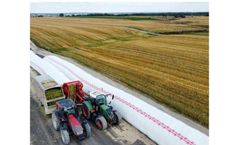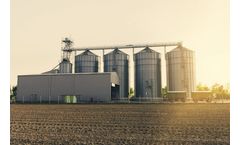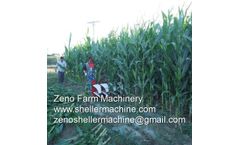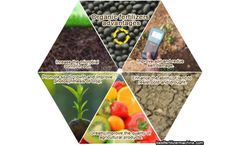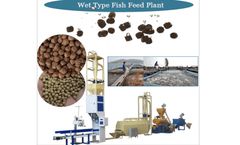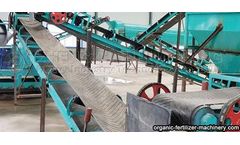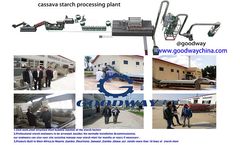Grain Yield Production Articles & Analysis
60 articles found
“Bagged silage can have a huge impact on profitability, herd health, and milk production,” says Bonni Kowalke, fermentation researcher, practitioner and owner of Stem Ag Consulting, LLC., a firm that specializes in monitoring and optimizing dairy farm inputs and outputs at all forage production stages. ...
From Leasing to Wind Farms to Owning His Own. Cosmos, Minnesota (USA), sits along the South Fork of the Crow River. Grain is the lifeblood of the small city, having been founded in 1867 by a pair of wheat farmers. ...
ByEocycle
BiOWiSH Technologies, Inc. engaged Precision Study Management as a third party Contract Research Organization (CRO) to conduct a study to determine the effects of BiOWiSH Crop Liquid coated urea on grain sorghum production in Markham, Texas, ...
Meeting the food requirements of a growing global population is becoming increasingly difficult. Despite the need for additional food, it is estimated that 50-60% of grain is lost after harvesting, at a cost of about $1 trillion per year.1 One of the major reasons for lost grain is spoilage due to mould or insect infestation during storage.2 To provide a constant supply of grain year-round, after ...
Along with that, it needs large scale farms, modern technologies, innovative farm machinery, good irrigation methods, chemical fertilizers etc. to produce a high yield. Commercial farming has the main feature consisting of modern inputs for higher productivity like good fertilizers, pesticides, weed killers and many more. ...
The actual utilization rate of chemical fertilizer in many areas is only 30% - 45%, and even lower in some areas! After applying organic fertilizer, due to its beneficial biological activity, the soil structure was improved, the soil water and fertilizer retention capacity was increased, the loss of nutrients was reduced, and the effective utilization rate of chemical fertilizer was increased to ...
Thousand kernel weight (TKW) is a yield component, and protein rate is a price component. Both are important parameters to farmers and depend on photosynthetical activity as well as nitrogen availability. Up to 50% of photosynthetical activity of wheat is due to the flag ...
The most and least productive areas in each field are then matched with the corresponding seed rates and applications. ...
ByGrowers
Feeding is the most important task in the intensive pond production of catfish, in a normal situation, for catfish can be seen only when they are coming up to feed, and their feeding behavior can be an important clue to general health and to other conditions in the pond. Zhengzhou Fusmar Machinery is a professional fish feed pellet machine manufacturer, if you need a fish feed production line, ...
Fertilizer is one of the decisive factors for the high yield and quality of grain. The use of fertilizer has made a great contribution to the increase of crop production and the alleviation of food shortage. ...
Starch is one of the most abundant substances in nature, a renewable and almost unlimited resource. Starch is produced from grain or root crops. It is mainly used as food, but is also readily converted chemically, physically, and biologically into many useful products to date, starch is used to produce such diverse products as food, paper, textiles, adhesives, beverages, confectionery, ...
The alumina abrasive having a microcrystalline structure obtained by the gel method is called the ceramic grains. Through special processing, each grain has thousands of tiny crystals. This structure brings the very good self-sharpness performance of the grains, which can continuously reveal new and sharp cutting edges. RIKEN RMC Ceramic grains are very dense, rough, strong and sharp. When worn, ...
dry fish feed extruder machine philippines Extrusion processing technology has become of major importance in the production of modern feeds used in intensive aquaculture. In recent years there has been a constant growth in the application of extruded diets for aquatic feeding. Aquatic feed by extrusion have superior water stability, better floating property and a higher energy than pelleted ...
The system by which we grow and distribute grain is well over a hundred years old. In the early 1900s, with significant urban migration, came the need for an efficient way to transport crops from rural areas to city centers. This led to the development of a commodity system, in which growers brought their harvested grain to silos where it was mixed with their neighbors’. Growers were paid a ...
Meeting the food requirements of a growing global population is becoming increasingly difficult. Despite the need for additional food, it is estimated that 50-60% of grain is lost after harvesting, at a cost of about $1 trillion per year.1 One of the major reasons for lost grain is spoilage due to mould or insect infestation during storage.2 To provide a constant supply of grain year-round, ...
Scientists and physicians are looking for clues to a worrying increase in fungal infections and exploring ways to reduce the threat. Fungi are everywhere — from the mushrooms that decompose fallen logs in the forest, to the mold that grows in your bathtub, to the microscopic fungal cells that reside naturally on your skin. Scientists estimate there are 1.5 million species of fungi on the ...
ByEnsia
North China Plain is one of the most important grain-producing areas in China. Because of unevenly distributed precipitation in this semi-arid area, crop production largely relies on underground blue water (UBW) to irrigate, overexploitation of which causes a lot of environmental problems. In this paper, we first defined the representative division of winter wheat irrigation water production ...
In the late 1900s, as per-acre grain yields moved to 3 metric tons per hectare in South and Southeast Asia and Latin America, 5 metric tons per hectare in China, and 10 metric tons per hectare in North America, Europe and Japan, there’s one place where production stagnated big time: sub-Saharan Africa, where loss of soil fertility on small ...
ByEnsia
India is mainly an agricultural county and is also the largest contributors in the GDP of the country. Agriculture provides employment to a huge population of the rural India. This was not the case suddenly post-independence in India. Various steps were taken to make India as a reliable agricultural country. Steps such as green revolution were taken in several five years plan. This has made India ...
Meanwhile, water supplies are being diverted to nonfarm uses and cropland is being lost to urban and industrial construction. With China’s grain yield already among the highest in the world, the potential for China to increase production within its own borders is limited. ...

